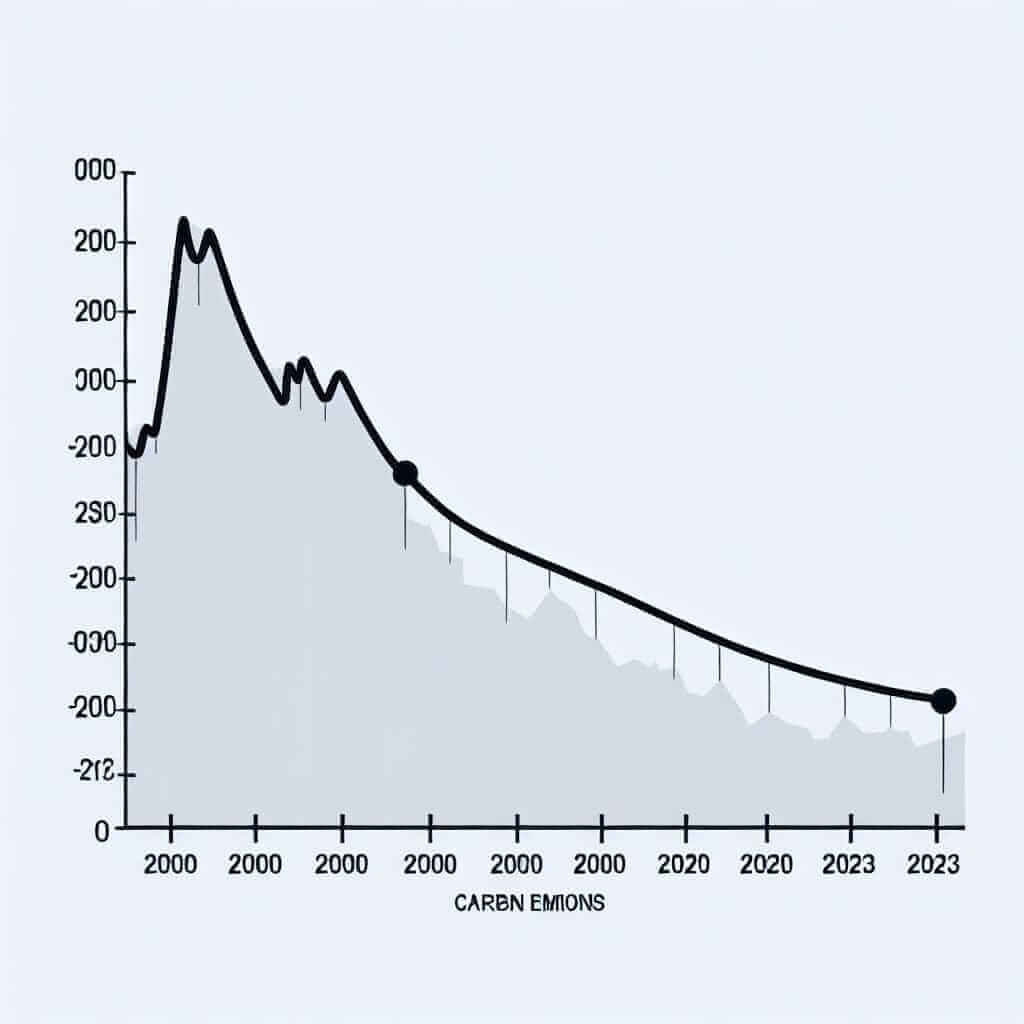The average household carbon footprint is a popular topic in IELTS Writing Task 1 due to its relevance to environmental issues and the availability of measurable data over time. The carbon footprint refers to the total greenhouse gases emitted by an individual household, primarily through activities like transportation, electricity usage, heating, and waste. Understanding these trends over time can help candidates gain useful insights into environmental changes and how to describe data effectively in Writing Task 1.
Introduction
The average household carbon footprint is an important indicator of environmental impact. For IELTS candidates, understanding how to describe these trends quantitatively and qualitatively is crucial for success in Writing Task 1, which frequently involves interpreting charts, graphs, and tables.
In this post, we will:
- Discuss the trends in average household carbon footprint from 2000 to 2023.
- Create a model IELTS Writing Task 1 essay based on these trends.
- Provide specific vocabulary and grammatical structures to excel in this task.
We will start by creating some plausible data to use as a reference for our essay.
Average Household Carbon Footprint (Data Representation)
Hypothetical Data Table
| Year | CO2 Emissions (Metric Tons/Household) |
|---|---|
| 2000 | 10.5 |
| 2001 | 10.3 |
| 2002 | 10.1 |
| 2003 | 9.9 |
| 2004 | 9.7 |
| 2005 | 9.5 |
| 2006 | 9.3 |
| 2007 | 9.1 |
| 2008 | 8.8 |
| 2009 | 8.5 |
| 2010 | 8.2 |
| 2011 | 8.0 |
| 2012 | 7.7 |
| 2013 | 7.5 |
| 2014 | 7.3 |
| 2015 | 7.0 |
| 2016 | 6.8 |
| 2017 | 6.6 |
| 2018 | 6.4 |
| 2019 | 6.2 |
| 2020 | 6.0 |
| 2021 | 5.8 |
| 2022 | 5.5 |
| 2023 | 5.3 |
Hypothetical Line Graph
(For the purpose of this model, imagine a line graph visual where the X-axis represents the years from 2000 to 2023, and the Y-axis represents the carbon emissions in metric tons per household. The line steadily declines from 10.5 in 2000 to 5.3 in 2023.)
 Average Household Carbon Footprint 2000-2023
Average Household Carbon Footprint 2000-2023
Analyzing the Data
The average household carbon footprint data from 2000 to 2023 shows a clear decreasing trend. Over the 23-year period, household emissions have been halved from 10.5 metric tons in 2000 to 5.3 metric tons in 2023. This suggests significant improvements in energy efficiency, adoption of renewable energy sources, and lifestyle changes aimed at reducing carbon emissions.
Model Essay
Task: Summarize the information by selecting and reporting the main features, and make comparisons where relevant.
Essay
The line graph illustrates the changes in the average household carbon footprint from 2000 to 2023. Overall, there has been a notable decline in carbon emissions per household over the given period.
In 2000, the average household emitted 10.5 metric tons of CO2. This figure saw a gradual decrease over the initial years, falling to 9.5 metric tons by 2005. The reduction trend continued more sharply from 2006 onwards, with emissions dropping consistently every year. By 2010, the average household carbon footprint had reduced to 8.2 metric tons.
The pace of reduction became more pronounced after 2012, indicating potential improvements in energy efficiency and greater awareness of environmental impact. By 2015, the emissions had notably dropped to 7.0 metric tons, and by 2018, they further declined to 6.4 metric tons. The most significant reduction is observed in the last five years of the period, culminating in a low of 5.3 metric tons per household by 2023.
Several factors could account for this downward trend. Advances in renewable energy technology, increased use of energy-efficient appliances, and heightened public awareness of environmental issues likely contributed to these reductions. Additionally, governmental policies aimed at reducing carbon emissions may have played a critical role.
In summary, the data clearly demonstrates a substantial reduction in household carbon footprints over the 23-year period, reflecting positive environmental progress and adaptation measures.
Word Count: 218 words.
Key Considerations When Writing
Vocabulary
- Carbon footprint (noun) [ ˈkɑːr.bən ˈfʊt.prɪnt ] – the amount of carbon dioxide emissions for which an individual or group is responsible.
- Metric tons (noun) [ ˈme-trik tʌnz ] – a unit of measurement equal to 1,000 kilograms.
- Emissions (noun) [ ɪˈmɪʃ.ənz ] – the act of releasing something, especially gas or radiation.
- Renewable energy (noun) [ rɪˈnjuːə.bəl ‘ɛn.ər.dʒi ] – energy derived from natural processes that are replenished constantly, such as solar or wind power.
- Energy efficiency (noun) [ ˈɛnərdʒi əˈfɪʃ.ən.si ] – the goal to reduce the amount of energy required to provide products and services.
- Reduction (noun) [ rɪˈdʌk.ʃən ] – the action or fact of making something smaller or less in amount, degree, or size.
- Advances (noun) [ ædˈvænsɪz ] – a development or improvement.
Grammar Focus
When writing about trends in IELTS Writing Task 1, it is important to use appropriate tense and grammatical structures:
- Present Perfect Continuous Tense: “The average household carbon footprint has been declining steadily since 2000.”
- Comparative Forms: “The emissions in 2023 are significantly lower than in 2000.”
- Descriptive Adjectives: “The pace of reduction became more pronounced after 2012.”
- Causal Conjunctions: “Several factors could account for this downward trend, including improvements in energy efficiency and increased use of renewable energy sources.”
Conclusion
When tackling an IELTS Writing Task 1 essay on the average household carbon footprint, it’s vital to focus on key data trends, use precise vocabulary, and ensure grammatical accuracy. Practicing with real data and understanding the environmental context can help candidates craft high-quality responses and achieve their desired band scores.


